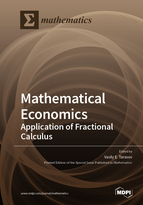Mathematical Economics: Application of Fractional Calculus
A special issue of Mathematics (ISSN 2227-7390). This special issue belongs to the section "Financial Mathematics".
Deadline for manuscript submissions: closed (20 February 2020) | Viewed by 52432
Special Issue Editor
Interests: fractional calculus; fractional dynamics; mathematical economics; quantum theory; theoretical physics; processes with memory
Special Issues, Collections and Topics in MDPI journals
Special Issue Information
Dear Colleagues,
Fractional calculus is a branch of mathematics that studies the properties of differential and integral operators that are characterized by real or complex orders. Methods of fractional calculus are powerful tools for describing the processes and systems with memory and nonlocality. There are various types of fractional integral and differential operators that are proposed by Riemann, Liouville, Grunwald, Letnikov, Sonine, Marchaud, Weyl, Riesz, Hadamard, Kober, Erdelyi, Caputo and other mathematicians. The fractional derivatives have a set of nonstandard properties such as a violation of the standard product and chain rules. The violation of the standard form of the product rule is a main characteristic property of derivatives of non-integer orders that allows us to describe complex properties of processes and systems.
Recently, fractional integro-differential equations are actively used to describe a wide class of economical processes with power-law memory and spatial nonlocality. Generalizations of basic economic concepts and notions the economic processes with memory were proposed. New mathematical models with continuous time are proposed to describe the economic dynamics with long memory.
The purpose of this Special Issue is to create a collection of articles reflecting the latest mathematical and conceptual developments in mathematical economics with memory and non-locality based on applications of modern fractional calculus.
Prof. Dr. Vasily E. Tarasov
Guest Editor
Manuscript Submission Information
Manuscripts should be submitted online at www.mdpi.com by registering and logging in to this website. Once you are registered, click here to go to the submission form. Manuscripts can be submitted until the deadline. All submissions that pass pre-check are peer-reviewed. Accepted papers will be published continuously in the journal (as soon as accepted) and will be listed together on the special issue website. Research articles, review articles as well as short communications are invited. For planned papers, a title and short abstract (about 100 words) can be sent to the Editorial Office for announcement on this website.
Submitted manuscripts should not have been published previously, nor be under consideration for publication elsewhere (except conference proceedings papers). All manuscripts are thoroughly refereed through a single-blind peer-review process. A guide for authors and other relevant information for submission of manuscripts is available on the Instructions for Authors page. Mathematics is an international peer-reviewed open access semimonthly journal published by MDPI.
Please visit the Instructions for Authors page before submitting a manuscript. The Article Processing Charge (APC) for publication in this open access journal is 2600 CHF (Swiss Francs). Submitted papers should be well formatted and use good English. Authors may use MDPI's English editing service prior to publication or during author revisions.
Keywords
- Fractional calculus
- Mathematical economics
- Fractional derivative
- Fractional integral
- Fractional difference
- Long memory
- Spatial non-locality
- Economic growth models
- Processes with memory






